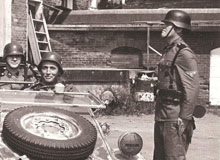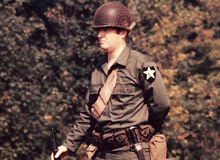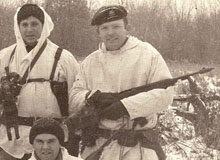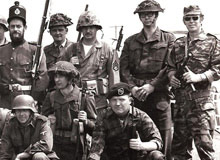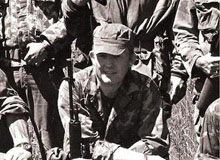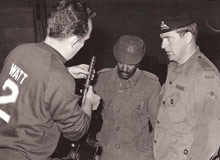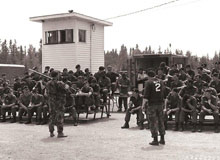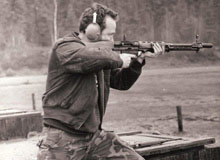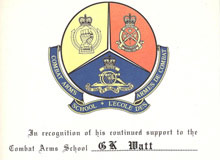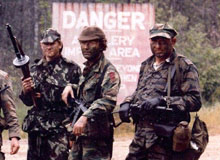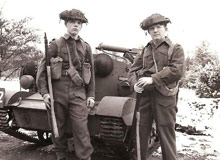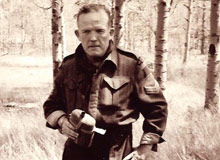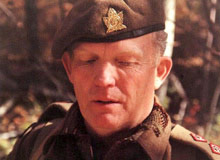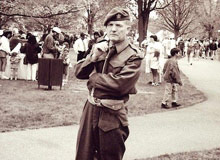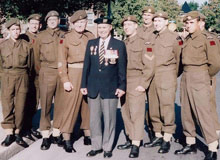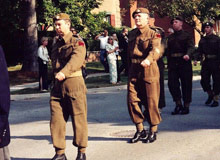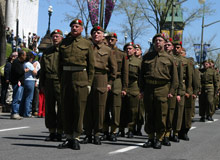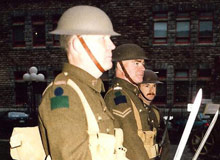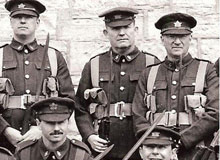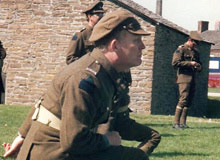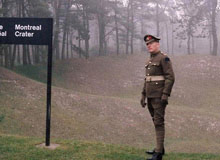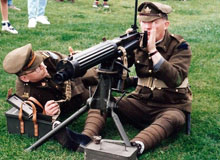About Gavin
More information: About Gavin | 18th Century Reenacting | 20th Century Reenacting | About Gavin & Family
20th CENTURY REENACTING
 Gavin began reenacting in 1965 when he and some friends founded Service Rifle Shooting Association, although no one referred to the hobby as ‘reenacting’ at the time. Gavin was the founding President and continued in that role until retiring in the 1980’s.
Gavin began reenacting in 1965 when he and some friends founded Service Rifle Shooting Association, although no one referred to the hobby as ‘reenacting’ at the time. Gavin was the founding President and continued in that role until retiring in the 1980’s.
Many of the club’s events were what Revolutionary War reenactors now call “private tacticals,” similar to the Brigade of the American Revolution’s wargames at Schroon Lake and, more recently, the Company of Select Marksmens’ events at Meyer’s Hill and the morning activities at the Burning of the Valley Military Association’s events at Lansing Manor.
Service Rifle quickly developed a public persona by staging “pageants” and mock battles – what are now called, “Time Line” and “Tactical Weapons’ Demonstration” events. These pageants often included static displays of arms, accoutrements and uniforms and were staged to support Canadian Forces Bases Borden, Kingston, Petawawa and Trenton and various Canadian and American historic sites such as Forts George, Niagara and York.
At times, the members were film extras, acting in multiple military roles as required by the story line.
For many years, Service Rifle served as an enemy force for Canadian Regulars and Reserves and American National Guard and Reserve Army units. In Canada, this involvement extended to ‘controlled enemy’ exercises with the Canadian Forces Officer’s Candidates School, Junior Leaders’ School and Intelligence and Security School and Borden’s Base Defence system. The last set of exercises with Canadian Regulars was held in 1982 at Petawawa in support of the base’s Military Police Platoon.
Simultaneously, the club participated in small arms’ range shoots at Base Borden, often with Canadian and American Regular and Reserve Army competitors.
Although unrelated to reenacting, the members’ in-depth knowledge led to a team becoming “Honorary Instructors” to NCO qualification courses at the Infantry Platoon, Combat Arms School in CFB Gagetown. This commitment continued for sixteen years. Similar demonstrations were provided at CFB’s Borden, North Bay and Petawawa and for some law enforcement agencies.
After a decade of this wide variety of activities, Service Rifle’s members decided they wanted to portray something more tangible and chose the King’s Royal Regiment of New York, a United Empire Loyalists’ regiment of the American Revolution. (please see 18th Century reenacting)
Two years later, Service Rifle founded the provincially chartered Museum of Applied Military History. “Museum” was a misnomer; however, it was the closest term to describe the association’s activities in the government’s lexicon. In today’s terminology, “Canadian Living History Society” would have been appropriate. At it's peak, MAMH membership included twenty-eight units from Ontario and the United States portraying four historical eras.
 In 1982, the membership decided to create two Second World War infantry units – one Canadian, one German – to permit the staging of historic mock battles. As the Canadian Criminal Code prevents anyone assuming the identity of modern military units, the Canadian representation was generic and named Maple Leaf Up after the road signs that directed troops to Canadian forward positions in Northwest Europe. The men wore CANADA flashes and the General List cap badge. Gavin and his son, Gavin Alexander, joined as privates.
In 1982, the membership decided to create two Second World War infantry units – one Canadian, one German – to permit the staging of historic mock battles. As the Canadian Criminal Code prevents anyone assuming the identity of modern military units, the Canadian representation was generic and named Maple Leaf Up after the road signs that directed troops to Canadian forward positions in Northwest Europe. The men wore CANADA flashes and the General List cap badge. Gavin and his son, Gavin Alexander, joined as privates.
Seven years later, Gavin and four other members formed a committee to choose a formal identity for the Second War unit. This took considerable research, as formal permission had to be obtained from the perpetuating regimental association and National Defence HQ, Ottawa. The unit selected was the Perth Regiment of 5th Canadian Armoured Division. When both permissions were in place, the new unit was launched at the Canadian War Museum in 1990. Gavin became the Corporal of No.9 Section in 1991 and, by 1993, was Sergeant of 18 Platoon. When the platoon was able to field three solid sections, Gavin ‘badged’ as Lieutenant.
After a few years, he became Company Sergeant Major to make room in the command chain for younger men. A few years later, he stepped away from that role and returned to the ranks as a Private in No.7 Section, from which he retired in 2009.
`At the same time as the idea about the Perth project was gestating, a Great War section was under development in Ottawa. After three years of representing various regiments of the Canadian Expeditionary Force, it was decided to adopt the identity of a single regiment – the 20th (Central Ontario) Battalion of 2nd Infantry Division. Under imaginative leadership, the 20th experienced reenacting on a grand style. There were several appearances commemorating important Great War events and annual training camps were held at Historic Forts York and George. A highlight was a trip to Europe to commemorate the 75th anniversary of the end of the Great War. A 12-man section made visits to many historic battlefields, cemeteries and landmarks and made ceremonial appearances at Vimy Ridge, the Menin Gate and finally Mons, where the Canadian Expeditionary Force ended the war on the 11th hour of the 11th day. The recreated 20th Battalion was the only Canadian military presence at this momentous location on this momentous occasion, except for a serving Air Force colonel, his wife and driver. The 20th Battalion continues to this day providing animation and static displays at diverse locations like CFB Borden; the National War Memorial in Ottawa; McCrae House in Guelph; the Billy Bishop Museum in Owen Sound and with the Royal Canadian Legion in Newmarket.
